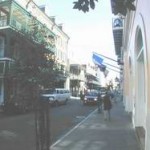- Denser development can be more pedestrian friendly and have a higher quality of life. (New Orleans French Qtr)
- Automobile-dependent development eats up land! (Clear Lake area, Houston)
- Denser development saves habitat! (Curry Lake, TX)
What is Smart Growth?
Smart Growth is growth that preserves quality of life as well as quality of the environment. It is a framework that informs sustainable urban development. There are many facets to smart growth, as well as many different “flavors”. Here we define smart growth as those policies and practices that impact the pattern of urban development in such a way that impacts to air and water quality are restricted to smaller areas.
The actual impacts may be greater than so-called “green development” in the areas that are disturbed, but the impact to the overall ecosystem is less because greater amounts of undisturbed green space can be preserved.
What does Smart Growth Look Like?
Salon des Refuses – A radical counterproposal to “Low Impact Development”
An avante garde design based on principles of proximity and walkability
Resources
BOOKS
The Death and Life of Great American Cities. Jane Jacobs. Vintage Books. A ground breaking work. Over 30 years old but not at all dated. A common sense book by a woman completely outside the profession. Maybe thats why it reads so good.
How Cities Work : Suburbs, Sprawl, and the Roads Not Taken. 2001. Alex Marshall. An eye-opening book. One of the most important on the subject. Cities, not developers, are responsible for the pattern and shape of urban development.
Cities in Full. Recognizing and realizing the great potential of Urban America. 2002. Steve Belmont. Planners Press. American Planning Association. Chicago, IL. One of the most important books you can read on this subject. Recentralization of the urban core is the central thesis of this book. Chock-a-block full of tables and statistics. A long book, but a must-read.
Design with Nature. Ian McHarg. 1992. John Wiley and Sons (Reprint of 1969 original). The original smart growth manual. Pay attention to the landscape!
The Regional City. 2001. Peter Calthorpe and William Fulton. Planning for the End of Sprawl.
The Next American Metropolis. Ecology, Community, and the American Dream. 1993. Peter Calthorpe. Princeton Architectural Press. This book presents 24 of Calthorpe’s regional urban plans, in which towns are organized so that residents can be less dependent upon their cars and can walk, bike, or take public transportation between work, school, home, and shopping.
Conservation Design for Subdivisions. A practical guide to creating open space networks. 1996. Randall G. Arendt. Island Press. The author proposes a step-by-step approach to conserving natural areas by rearranging density on each development parcel as it is being planned so that only half (or less) of the buildable land is turned into houselots and streets. This is planning on a subdivision rather than on a city level.
Suburban Nation: The Rise of Sprawl and the Decline of the American Dream. 2001. Andres Duany, Elizabeth Plater-Zyberk, Jeff Speck. North Point Press. An excellent introduction to the problems of sprawl and available solutions.
Some Tools
Getting to Smart Growth: 100 Policies for Implementation
A publication of the Smart Growth Network and the International City/County Management Association. (order hardcopy here)
Smart Growth Zoning Codes: A Resource Guide
This $20 guidebook will help planners design a zoning code that encourages the construction of walkable, mixed use neighborhoods and the revitalization of existing places.
LINKS
- Smart Growth America
Smart Growth America is a coalition of nearly 100 advocacy organizations that have a stake in how metropolitan expansion affects our environment, quality of life and economic sustainability. - USEPA Smart Growth
An excellent resource for smart growth topics. - Smart Growth Online
A resource of the Smart Growth Network Browse under Resources by issue or principle for a good introduction to smart growth ideas. - Congress for New Urbanism
New Urbanism is a “flavor” of smart growth that focuses on the details of sustainable urban planning. - James Taylor Chair in Landscape and Liveable Environments (Univ. of British Columbia)
A very information-rich site. Much of the information is specific to British Columbia, but the principles are universal - National Town Builders Association
NTBA “are town builders committed to the successful development of smart growth neighborhoods that are economically, socially and environmentally sustainable.” - Local Government Commission Center for Liveable Communities
Many valuable fact sheets and resources.
 Texas Community Watershed Partners
Texas Community Watershed Partners 


